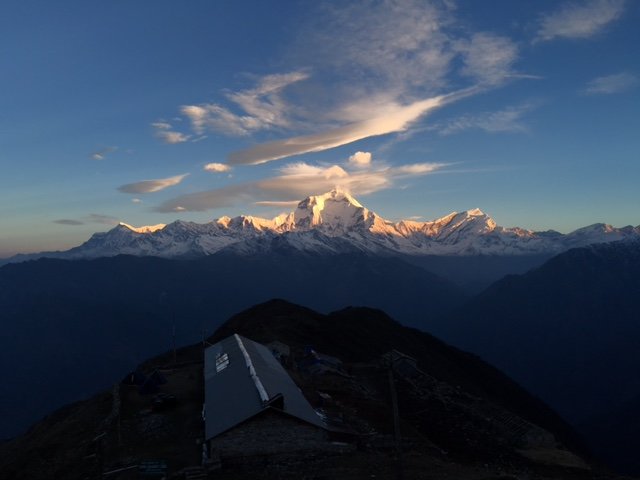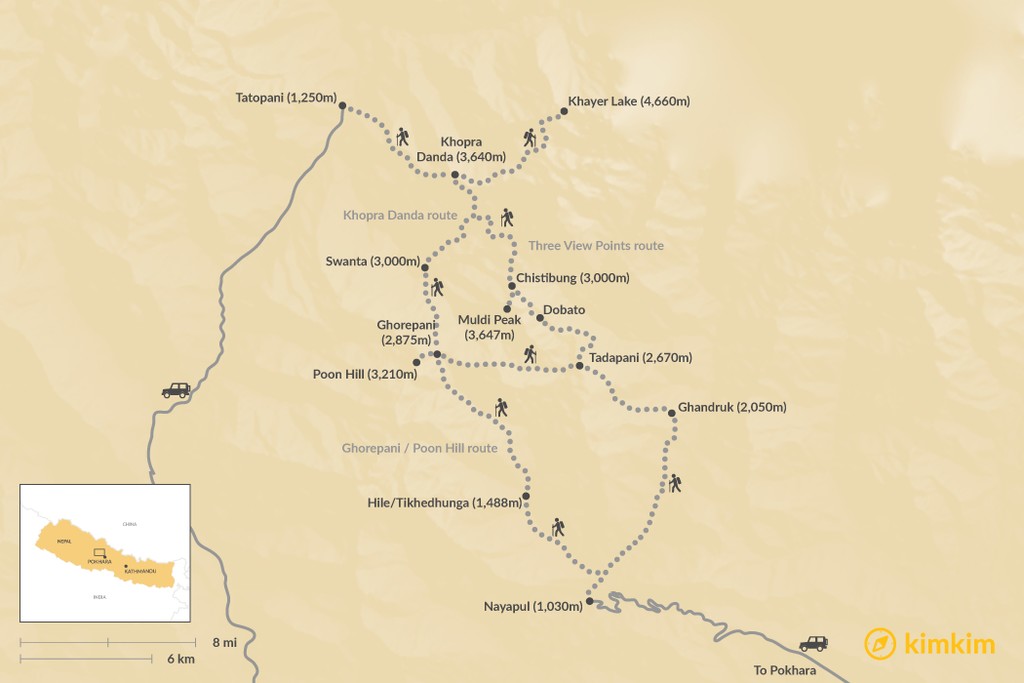
The Annapurna foothills make for some of the best short treks in Nepal: classic views of Nepal’s famous snow-capped peaks, a variety of routes ranging from 3-10 days, and relatively easy trekking given the altitude and local village teahouses.
A comprehensive network of locally maintained village trails, intertwined with well-established teahouse trekking routes, allows for the creation of a diverse range of custom itineraries. These itineraries can range from the quintessential Ghorepani / Poon Hill trek, a favorite among many, to the more secluded and less-traveled paths that ultimately lead to the stunning Khopra Danda and even further beyond. Below, you’ll discover a curated selection of excellent options, each of which can be meticulously customized to perfectly align with your preferred number of days for the adventure and the desired level of difficulty you seek in your trekking experience.
## Suggested Routes
There exists a multitude of captivating routes available to access the breathtaking vantage points and charming villages nestled within this remarkable region. Each and every one of these routes can be carefully tailored to seamlessly fit your desired pace and the specific duration of your trek. The majority of routes typically commence with a scenic jeep or bus ride from the vibrant city of Pokhara to the starting point in Nayapul, where your trekking journey officially begins.
### Classic: Ghorepani / Poon Hill (5 days)
This is the classic route. A journey that involves traversing meticulously constructed stone steps that wind their way through picturesque villages and lush rhododendron jungles, ultimately culminating in the teahouse village of Ghorepani. Ghorepani is strategically perched upon a ridge line. From this village it is only a short climb to reach the summit of Poon Hill.
Day 01: The journey begins with a transfer from Pokhara to the charming village of Hile.
Day 02: From Hile, the trail ascends to the village of Ghorepani. A pre-dawn hike is essential to experience the sunrise from the renowned Poon Hill.
Day 03: The route continues from Ghorepani to the picturesque settlement of Tadapani.
Day 04: Trek from Tadapani to the beautiful village of Ghandruk, known for its stunning views.
Day 05: The final day involves descending from Ghandruk back to the city of Pokhara.
### More Remote: Khopra Danda (6 days)
After initially following the same well-trodden route towards Ghorepani, this particular route diverges and elevates you to an even higher altitude. You will reach another remarkable viewpoint situated at an impressive 3600 meters above sea level. This viewpoint offers a unique perspective, positioned directly across the valley from the ever-popular Poon Hill. This more remote route currently welcomes significantly fewer travelers compared to other routes in the region. However, it generously rewards those who venture upon it with some of the most awe-inspiring and unforgettable views that you will encounter anywhere in Nepal. You’ll have the opportunity to stay at a unique teahouse. This single teahouse is perched atop the ridge, offering you expansive 360-degree panoramic views of the majestic Himalayan massifs. The views are particularly breathtaking when the sun rises and sets, bathing the peaks in a warm, golden light. (Note: A new teahouse was under construction and expected to be completed by 2018).
Day 01: The trek commences with a journey from Pokhara to the village of Hile.
Day 02: From Hile, the trail leads to Ghorepani.
Day 03: A hike from Ghorepani to Swanta, enhanced by a very early morning ascent to witness the sunrise from Poon Hill.
Day 04: The path continues from Swanta to Khopra Danda. There is the option to incorporate an extra day for a side trip to the sacred Khayer Lake.
Day 05: If opting for the extra day, enjoy a day trek dedicated to exploring Khayer Lake.
Day 06: The trek concludes with a descent from Khopra Danda to the village of Tatopani.
### Three View Points: Poon Hill / Khopra Danda / Muldi Peak (9 days)
This itinerary takes in three amazing view points.
Day 01: Begin with a journey from Pokhara to the village of Ghandruk.
Day 02: The trail leads from Ghandruk to Tadapani.
Day 03: Trek from Tadapani to Dobato.
Day 04: Hike from Dobato to Chistibung. A very early morning ascent to Muldi Peak to greet the rising sun is highly recommended.
Day 05: The path continues from Chistibung to Khopra Danda.
Day 06: From Khopra Danda, descend to the village of Swanta.
Day 07: Continue trekking from Swanta to Ghorepani.
Day 08: A hike from Ghorepani to Hile, with an early morning excursion to Poon Hill for sunrise views.
Day 09: The trek concludes with a return journey from Hile back to the city of Pokhara.
## Elevation Profile
In a remarkably short amount of time, you have the incredible opportunity to access three truly exceptional vantage points. These vantage points are normally only reached after numerous days of dedicated trekking and require proper acclimatization to the altitude. These vantage points include the iconic Poon Hill, standing tall at 3200 meters, the stunning Khopra Danda, reaching an elevation of 3600 meters, and the majestic Muldi Peak, soaring to 3647 meters. Each of these locations offers breathtaking panoramic views of some of the world’s most magnificent mountains. This includes the imposing Dhaulagiri, the elegant Nilgiri, the majestic Annapurna South, the towering Annapurna I, and the distinctive Macchupucharre (which can be exclusively observed in its full glory from the summit of Muldi Peak).
## Difficulty
Trekking anywhere within the borders of Nepal naturally presents a certain level of challenge. This is due to the frequently steep inclines that are required to reach the various vantage points, as well as the significant altitude that one must contend with. Generally speaking, however, the treks that are located within the lower Annapurna region typically offer a more balanced experience. These treks offer a blend of both easy and moderate trekking conditions, largely attributed to the relatively lower elevations compared to other trekking destinations in Nepal.
## Knowing The Seasons
### Spring – March to May
Spring presents the second most ideal time of year to embark on a trek in this region. The temperatures tend to be slightly warmer compared to the autumn months. There is also still a relatively high probability of experiencing clear and unobstructed skies, which is ideal for photography.
### Monsoon – June to September
The period from June to September marks the arrival of the heavy monsoon rains. The rain typically commences in June and persists, with approximately one rainfall event per day, until the early weeks of September. Generally speaking, this season is not considered the most favorable time for trekking. This is primarily due to the combined factors of high heat and the presence of leeches that thrive in the jungle environment.
### Fall – September to December
The skies typically begin to clear up around mid-September. The temperatures become significantly more comfortable, creating ideal conditions for trekking. However, it is still advisable to pack a few extra layers of clothing to adequately prepare for the potentially cold and windy weather that can occur at higher altitudes.
### Winter – December to February
During the winter months, you can still anticipate enjoying stunning and captivating views. However, be prepared to face colder nighttime temperatures. You should also prepare for the potential for snowy weather conditions, and the possibility of encountering slippery patches along the trail.
## Permits
To legally trek in this region, you will need to obtain the necessary permits. This involves arranging both a TIMS (Trekkers’ Information Management System) card and an ACAP (Annapurna Conservation Area Project) permit. These permits can be acquired from one of the Nepal Tourism Board offices located in either Kathmandu or Pokhara. Along the trekking routes, you will encounter various checkpoints. At these checkpoints, you will be required to present your permits and register your name in the logbook. This procedure serves dual purposes, ensuring your safety and aiding in the monitoring of trail activity. If you choose to organize your trek through a reputable trekking agency, they will typically handle the arrangement of these permits on your behalf, streamlining the process for you.

B-1817
